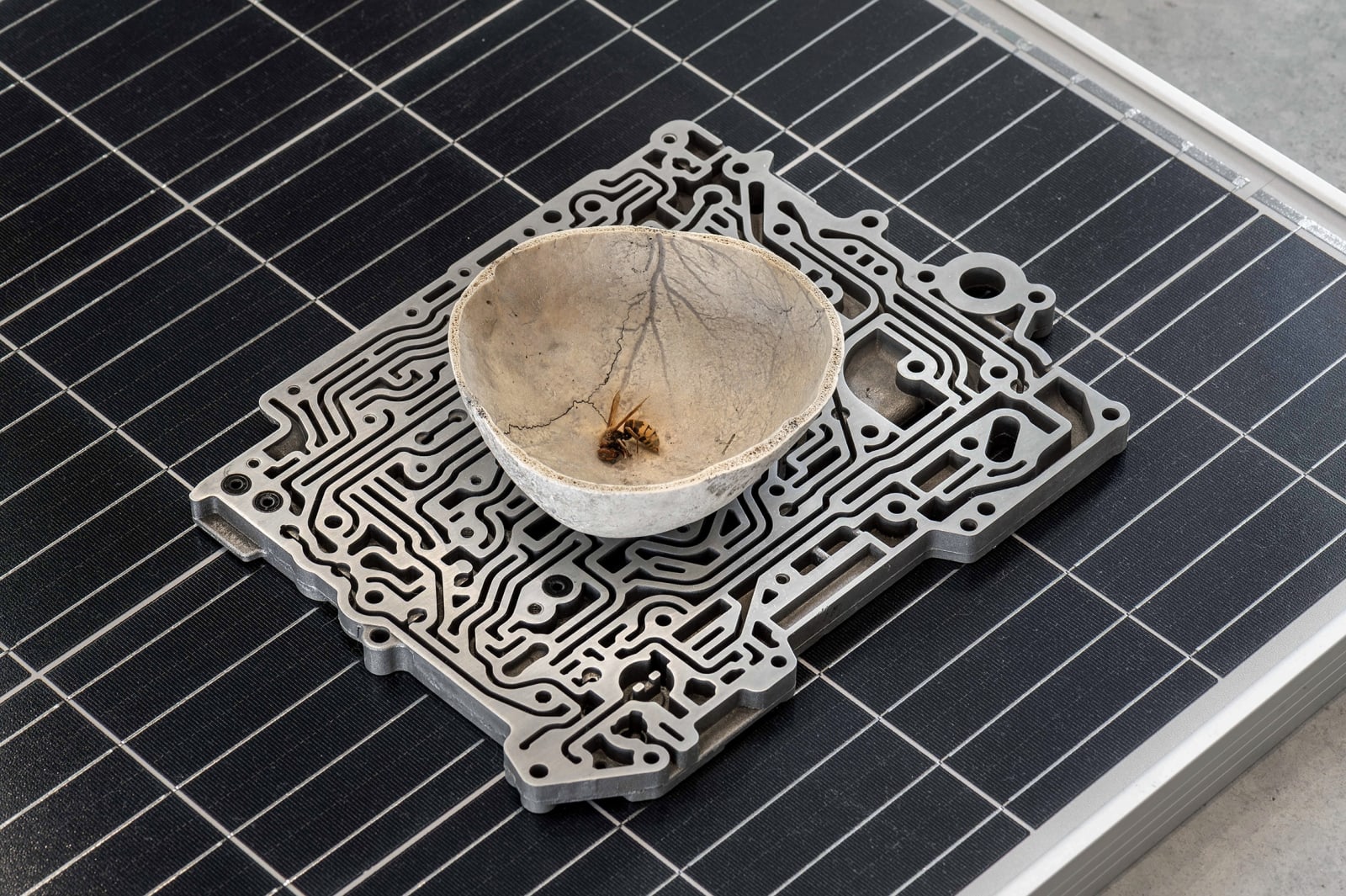Open a larger version of the following image in a popup:
 Photo: Marjorie Brunet Plaza (edited by Studio Nicolás Lamas)
Photo: Marjorie Brunet Plaza (edited by Studio Nicolás Lamas)
 Photo: Marjorie Brunet Plaza (edited by Studio Nicolás Lamas)
Photo: Marjorie Brunet Plaza (edited by Studio Nicolás Lamas)
Open a larger version of the following image in a popup:
 Photo: Studio Nicolás Lamas
Photo: Studio Nicolás Lamas
 Photo: Studio Nicolás Lamas
Photo: Studio Nicolás Lamas
Open a larger version of the following image in a popup:
 Photo: Studio Nicolás Lamas
Photo: Studio Nicolás Lamas
 Photo: Studio Nicolás Lamas
Photo: Studio Nicolás Lamas
Open a larger version of the following image in a popup:
 Photo: Studio Nicolás Lamas
Photo: Studio Nicolás Lamas
 Photo: Studio Nicolás Lamas
Photo: Studio Nicolás Lamas
Nicolás Lamas
Nest, 2023
Transmission valve body, human skull and wasp
31 x 25 x 8 cm
12 1/4 x 9 7/8 x 3 1/8 inches
12 1/4 x 9 7/8 x 3 1/8 inches
Copyright The Artist
Photo: Marjorie Brunet Plaza | Studio Nicolás Lamas
Further images
In „Nest“ (2023) und „Errored codes“ (2025) verbindet Lamas Fragmente menschlicher Schädel mit Wespen, deren Nestern und Silizium-Wafern – alles Teile biologischer, kollektiver und technologischer Denksysteme, die Fragen nach Bewusstsein...
In „Nest“ (2023) und „Errored codes“ (2025) verbindet Lamas Fragmente menschlicher Schädel mit Wespen, deren Nestern und Silizium-Wafern – alles Teile biologischer, kollektiver und technologischer Denksysteme, die Fragen nach Bewusstsein und der Verarbeitung von Informationen und Gesellschaft aufwerfen. Die filigrane Architektur des Wespennests steht symbolisch für Schwarmintelligenz, ein emergentes, eigenständiges System, das ohne zentrale Steuerung existiert und dennoch auf komplexe Weise Strukturen hervorbringt. Im Gegensatz dazu verweist die maschinelle Komponente auf die präzisen Steuerungsprozesse der Technik und offenbart das Ineinandergreifen natürlicher und konstruierter Systeme. Der menschliche Schädel tritt in einen direkten Dialog mit Strukturen einer nicht kognitionsgesteuerten Intelligenz, und so entfaltet sich das Spannungsfeld zwischen biologischer und künstlicher Intelligenz. Lamas lässt nicht nur das Potenzial technologischer Erweiterung aufleuchten, sondern beleuchtet auch deren Zerbrechlichkeit, Fehleranfälligkeit und die Grenzen des Digitalen. Beide Werke spiegeln Lamas’ zentrales Interesse an Übergängen, Hybridität und dem Spiel der Gegensätze wider. Sie offenbaren, dass Intelligenz nicht nur dem menschlichen Geist vorbehalten ist, sondern in unzähligen Formen existiert – im Tierreich, in der Maschine und in der symbiotischen Vereinigung beider.
In “Nest” (2023) and “Errored codes” (2025), Lamas combines fragments of human skulls with wasps, their nests and silicon wafers - all parts of biological, collective and technological thought systems that raise questions about consciousness and the processing of information and society. The delicate architecture of the wasps' nest symbolizes swarm intelligence, an emergent, independent system that exists without central control and yet produces structures in a complex way. In contrast, the machine component refers to the precise control processes of technology and reveals the interlocking of natural and constructed systems. The human skull enters into a direct dialog with structures of a non-cognitive intelligence, and thus the field of tension between biological and artificial intelligence unfolds. Lamas not only highlights the potential of technological expansion, but also sheds light on its fragility, susceptibility to error and the limits of the digital. Both works reflect Lamas' central interest in transitions, hybridity and the play of opposites. They reveal that intelligence is not exclusive to the human mind, but exists in myriad forms - in the animal kingdom, in the machine and in the symbiotic union of the two.
In “Nest” (2023) and “Errored codes” (2025), Lamas combines fragments of human skulls with wasps, their nests and silicon wafers - all parts of biological, collective and technological thought systems that raise questions about consciousness and the processing of information and society. The delicate architecture of the wasps' nest symbolizes swarm intelligence, an emergent, independent system that exists without central control and yet produces structures in a complex way. In contrast, the machine component refers to the precise control processes of technology and reveals the interlocking of natural and constructed systems. The human skull enters into a direct dialog with structures of a non-cognitive intelligence, and thus the field of tension between biological and artificial intelligence unfolds. Lamas not only highlights the potential of technological expansion, but also sheds light on its fragility, susceptibility to error and the limits of the digital. Both works reflect Lamas' central interest in transitions, hybridity and the play of opposites. They reveal that intelligence is not exclusive to the human mind, but exists in myriad forms - in the animal kingdom, in the machine and in the symbiotic union of the two.



